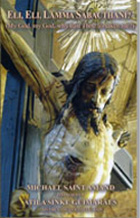Documents for your files
 |
PROGRESSIVIST DOCUMENTS
How Sheen's Ecumenical Seminary Came to Life
On the front page of the September 29, 1967 issue of The Catholic Courrier Journal, the Rochester NY diocesan newspaper, Bishop Fulton Sheen made a startling announcement to the Catholic faithful in an article titled “St. Bernard’s to Retain ‘Identity’ in Ecumenical Merger.” He announced that the diocesan Seminary was to be linked with two other Protestant clergy preparatory schools.
The paper reports: “The ecumenical aspects of the new arrangements, likely to go into effect in 1968, raised the inevitable question: ‘How can students for the Catholic priesthood learn their theology from Protestant professors?’”
It goes on to admit the question was already being asked when it was learned that Bishop Sheen had asked Protestant ministers “to teach sociology and sermon preparation techniques at St. Bernard’s Seminary this year.” But Catholics were even more concerned to learn that important classes in Scripture, theology and ethics would be shared, as well as library facilities that contain Protestant theology books, in the proposed new Center for Theological Studies at Rochester.
Bishop Sheen glibly answered the questions by stating the three theology schools – St. Bernard’s Seminary, the Baptist Colgate Rochester Divinity School and the Episcopalian Bexley Hall – “will work toward integration with identity.”
“In keeping with the spirit of ecumenism and the out-growing of the dichotomy of the Divine and the secular,” Sheen continued, “St. Bernard’s Seminary is desirous to unite with theological institutions in ministering to the world without losing itself. … Because other religious seminaries have recognized the double mission of being a servant and needing a Savior, the time has come to join with them in those things where we can help one another and save the world.”
The time had come for this “ecumenical theological center,” he said, so that Catholics could “become introduced to the elements of goodness and truth which other religions possess.” Further, we learn that “Colgate and Bexley have much to give St. Bernard’s.” This is a real innovation for the time, to publicly state that Protestant heretics could offer beneficial teaching to Catholic seminarians…
Bishop Sheen was so enthused with his seminary reforms that one month later, at the Bishops Synod meeting in Rome, he proposed to the close to 200 other Bishops at the world Synod that “all seminaries should do what he will do at St. Bernard’s Seminary – let competent laymen in on the running of the seminary ‘because some of them have a deeper spirit of faith than we find in some priests.’” (The Courier Journal, October 20, 1967, p. 2.)
The December 15, 1967 issue of the Catholic Courier reports that Bishop Sheen plan for an ecumenical seminary is going forward, with hopes that by 1970 a fourth Baptist seminary would be added to the ecumenical complex. (p. 23) Bishop Sheen explained the approach: “In those things we share in common, there will be unity; in those in which we differ, there will be dialogue and charity.”
It was a great frustration to Bishop Sheen that the ecumenical center had to be put on hold for several decades, reports the progressivist Rev. Robert McNamara in his work titled “Ecumenism and the Rochester Center for Theolgoical Studies.” (p. 17)
After several joint undertakings of the consortium, the distance between the South campus (the Protestant Divinity School) and the “North Campus” (St. Bernard’s) impeded fuller cross-registration and inter-school activities. Because of problems of student demonstrations that plagued the decade of the ‘60s, the plan to merge was abandoned in 1970. Only in 1981, with the closing of St. Bernard’s did the Bishop Sheen’s plan to merge with the Divinity Center come to realization. (Fr. Robert McNamara, The Diocese of Rochester in America, 1998, p. 18)
The “One-Campus Covenant of 1981” brought into being the “ecumenical seminary: envisioned by Bishop Sheen. He died two years before St. Bernard's Institute moved to the Divinity School buildings on“The Hill.” On the occasion of the singing of “the Covenant,” his fellow-promoter of affiliation, Dr. Gene Bartlett, observed: "The original vision sparked by Bishop Sheen in 1968 has finally been realized. This is a day of very special blessing." (Ibid., p. 21) Fr. McNamara concludes that Bishop Sheen is a prophetic figure for the ecumenical outreach.
Below, the announcement in the September 29, 1967 issue of The Catholic Courier that St. Bernad’s Seminary is seeking a merger with two Protestant facilities (see archived page here). Under it is the article on the Bishop’s proposal to the world Synod of Bishops to follow his suggested reforms for St. Bernard’s (see archived page here). It is followed by the front page article of the December 15, 1967 issue reporting on the progress of Bishop Sheen’s plan (see archived page here).
At the end of the page is a picture Bishop Sheen discussing plans for the ecumenical center with his good friend, Dr. Gene Bartlette, protestant president of Colgate Rochester Divinity School.
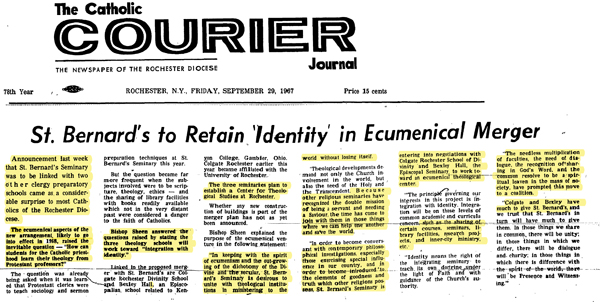
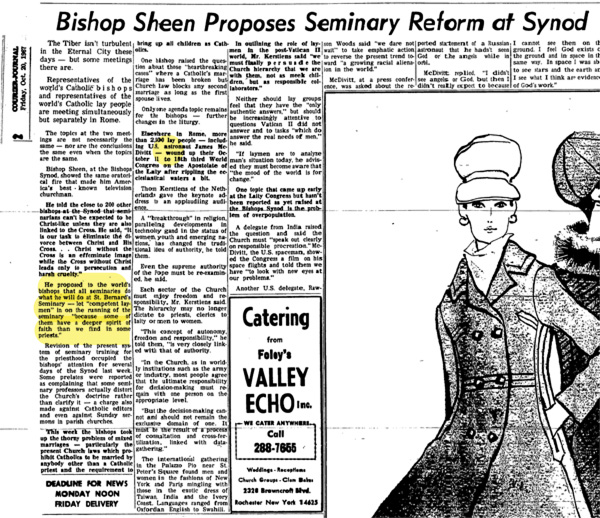
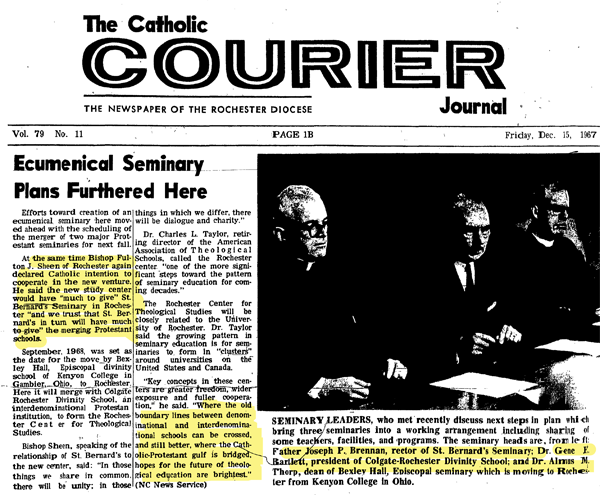
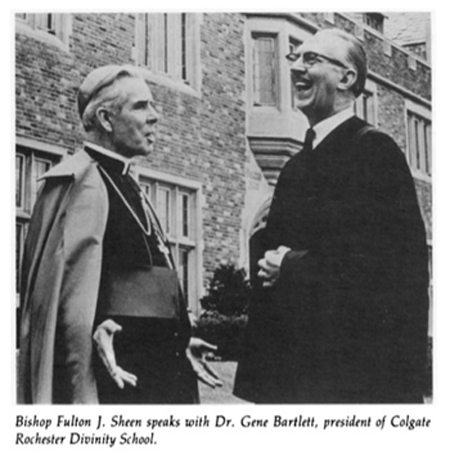
The paper reports: “The ecumenical aspects of the new arrangements, likely to go into effect in 1968, raised the inevitable question: ‘How can students for the Catholic priesthood learn their theology from Protestant professors?’”
It goes on to admit the question was already being asked when it was learned that Bishop Sheen had asked Protestant ministers “to teach sociology and sermon preparation techniques at St. Bernard’s Seminary this year.” But Catholics were even more concerned to learn that important classes in Scripture, theology and ethics would be shared, as well as library facilities that contain Protestant theology books, in the proposed new Center for Theological Studies at Rochester.
Bishop Sheen glibly answered the questions by stating the three theology schools – St. Bernard’s Seminary, the Baptist Colgate Rochester Divinity School and the Episcopalian Bexley Hall – “will work toward integration with identity.”
“In keeping with the spirit of ecumenism and the out-growing of the dichotomy of the Divine and the secular,” Sheen continued, “St. Bernard’s Seminary is desirous to unite with theological institutions in ministering to the world without losing itself. … Because other religious seminaries have recognized the double mission of being a servant and needing a Savior, the time has come to join with them in those things where we can help one another and save the world.”
The time had come for this “ecumenical theological center,” he said, so that Catholics could “become introduced to the elements of goodness and truth which other religions possess.” Further, we learn that “Colgate and Bexley have much to give St. Bernard’s.” This is a real innovation for the time, to publicly state that Protestant heretics could offer beneficial teaching to Catholic seminarians…
Bishop Sheen was so enthused with his seminary reforms that one month later, at the Bishops Synod meeting in Rome, he proposed to the close to 200 other Bishops at the world Synod that “all seminaries should do what he will do at St. Bernard’s Seminary – let competent laymen in on the running of the seminary ‘because some of them have a deeper spirit of faith than we find in some priests.’” (The Courier Journal, October 20, 1967, p. 2.)
The December 15, 1967 issue of the Catholic Courier reports that Bishop Sheen plan for an ecumenical seminary is going forward, with hopes that by 1970 a fourth Baptist seminary would be added to the ecumenical complex. (p. 23) Bishop Sheen explained the approach: “In those things we share in common, there will be unity; in those in which we differ, there will be dialogue and charity.”
It was a great frustration to Bishop Sheen that the ecumenical center had to be put on hold for several decades, reports the progressivist Rev. Robert McNamara in his work titled “Ecumenism and the Rochester Center for Theolgoical Studies.” (p. 17)
After several joint undertakings of the consortium, the distance between the South campus (the Protestant Divinity School) and the “North Campus” (St. Bernard’s) impeded fuller cross-registration and inter-school activities. Because of problems of student demonstrations that plagued the decade of the ‘60s, the plan to merge was abandoned in 1970. Only in 1981, with the closing of St. Bernard’s did the Bishop Sheen’s plan to merge with the Divinity Center come to realization. (Fr. Robert McNamara, The Diocese of Rochester in America, 1998, p. 18)
The “One-Campus Covenant of 1981” brought into being the “ecumenical seminary: envisioned by Bishop Sheen. He died two years before St. Bernard's Institute moved to the Divinity School buildings on“The Hill.” On the occasion of the singing of “the Covenant,” his fellow-promoter of affiliation, Dr. Gene Bartlett, observed: "The original vision sparked by Bishop Sheen in 1968 has finally been realized. This is a day of very special blessing." (Ibid., p. 21) Fr. McNamara concludes that Bishop Sheen is a prophetic figure for the ecumenical outreach.
Below, the announcement in the September 29, 1967 issue of The Catholic Courier that St. Bernad’s Seminary is seeking a merger with two Protestant facilities (see archived page here). Under it is the article on the Bishop’s proposal to the world Synod of Bishops to follow his suggested reforms for St. Bernard’s (see archived page here). It is followed by the front page article of the December 15, 1967 issue reporting on the progress of Bishop Sheen’s plan (see archived page here).
At the end of the page is a picture Bishop Sheen discussing plans for the ecumenical center with his good friend, Dr. Gene Bartlette, protestant president of Colgate Rochester Divinity School.



















